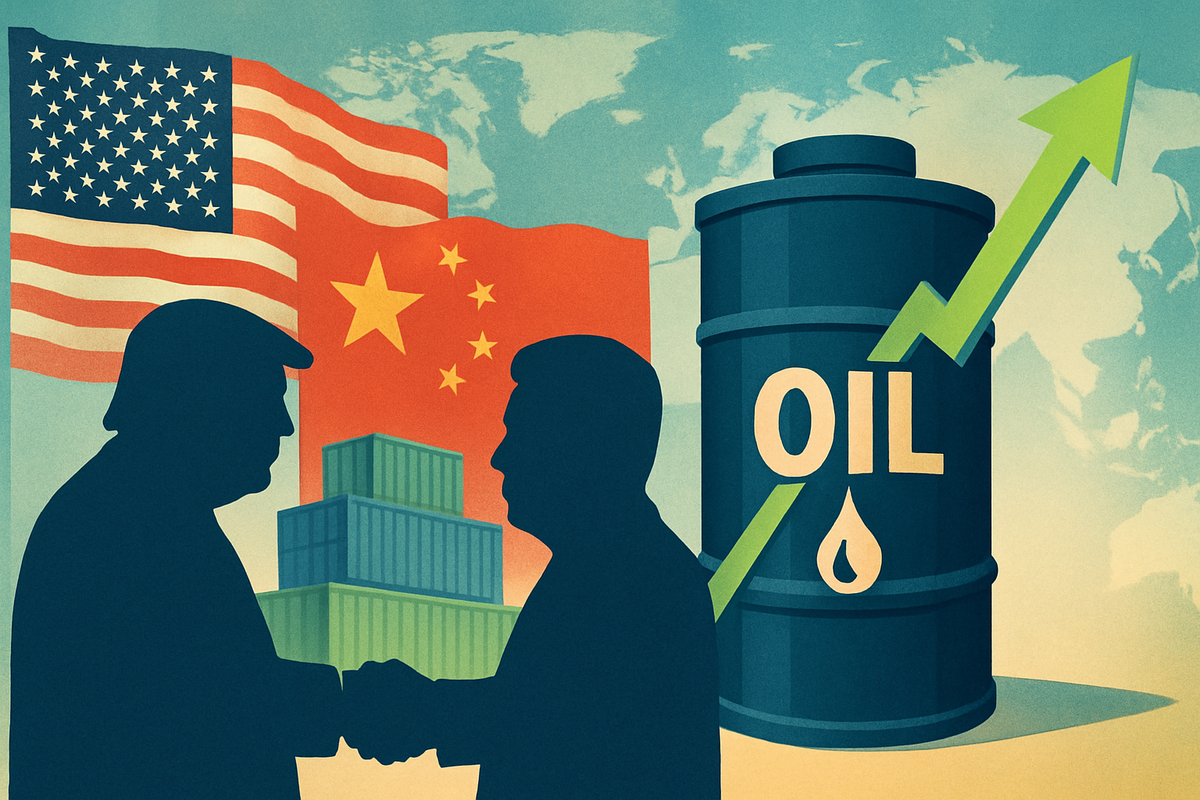
A temporary de-escalation in the fraught US-China trade war in December 2018, sparked by statements from then-President Donald Trump following a G20 summit, provided a much-needed jolt of optimism to global financial markets, leading to a significant rebound in oil prices. After months of escalating tariffs and fears of a global economic slowdown, the promise of a 90-day trade truce offered a brief reprieve, signaling to investors that a critical drag on global energy demand might be easing.
The agreement between President Trump and Chinese President Xi Jinping in Buenos Aires not only halted an impending tariff escalation but also rekindled hopes for a more stable global trade environment. This newfound, albeit fragile, confidence translated almost immediately into a surge in crude oil futures, pulling prices back from multi-month lows and offering a lifeline to an energy sector battered by oversupply concerns and weakening demand forecasts.
The Buenos Aires Breakthrough: A Detailed Account of the Trade Truce and Oil's Rally
The backdrop to the December 2018 events was a year marked by an intensifying trade war between the United States and China. Since early 2018, both economic superpowers had engaged in a tit-for-tat imposition of tariffs on billions of dollars worth of goods, fueling fears of a global recession and significantly dampening investor sentiment. Oil prices, particularly, had suffered, plummeting over 20% in November 2018 alone amidst concerns of a supply glut and reduced demand.
The pivotal moment arrived on December 1, 2018, on the sidelines of the G20 summit in Buenos Aires, Argentina. Following a dinner meeting, President Trump and President Xi Jinping announced a crucial 90-day trade truce. Under the terms of this agreement, the U.S. committed to postponing its planned increase of tariffs from 10% to 25% on $200 billion worth of Chinese goods, which was originally slated to take effect on January 1, 2019. In return, China pledged to purchase a "very substantial" amount of American agricultural, energy, and industrial products. President Trump further tweeted that China had agreed to "reduce and remove" its 40% tariffs on cars coming into China from the U.S., though this specific detail was not immediately confirmed by Beijing. Both sides also agreed to "immediately begin negotiations on structural changes" concerning long-standing U.S. grievances, including intellectual property protection, technology transfer, and non-tariff barriers.
The initial market reaction was overwhelmingly positive. Global stock markets, including Wall Street, rallied sharply on Monday, December 3, reflecting a wave of relief. Crucially for the energy sector, Brent crude futures, the international benchmark, surged by 4%, trading back above $60 a barrel to reach $62. West Texas Intermediate (WTI) crude futures also saw a significant rebound. This "relief rally" was driven by renewed hopes that the temporary de-escalation of the trade spat would mitigate the anticipated negative impact on global economic growth and, consequently, on worldwide energy demand. However, this initial euphoria was quickly tempered by confusion and conflicting statements regarding the specifics of the deal, leading to a significant stock market plunge by December 4, reminding investors of the fragility of the agreement and the deeply divisive issues that remained unresolved.
Winners and Losers: Corporate Fortunes in the Wake of Trade Détente and Oil's Ascent
The December 2018 trade truce and the subsequent oil price rebound created a varied landscape for public companies, with some poised to benefit significantly from reduced trade friction and rising energy prices, while others faced continued challenges.
Companies in the agricultural sector were among the primary beneficiaries of China's commitment to purchase "massive amounts" of US farm products. Agricultural equipment manufacturers like Deere & Co. (NYSE: DE), along with major food companies such as Cargill, Archer Daniels Midland (NYSE: ADM), and Tyson Foods (NYSE: TSN), saw a potential reopening of critical export markets that had been severely impacted by Chinese retaliatory tariffs, particularly on soybeans. The automotive sector also stood to gain if China followed through on its pledge to reduce or remove its 40% tariffs on US car imports. Automakers like Ford Motor Company (NYSE: F) and General Motors (NYSE: GM) could see their vehicles become more competitive in the lucrative Chinese market, potentially boosting sales and profitability.
For the technology sector, companies heavily reliant on Chinese manufacturing or sales, such as Apple Inc. (NASDAQ: AAPL), Nvidia Corp. (NASDAQ: NVDA), Micron Technology Inc. (NASDAQ: MU), and Intel Corp. (NASDAQ: INTC), benefited from the postponement of further tariff increases. This offered a temporary reprieve from escalating production costs and supply chain disruptions. Similarly, consumer discretionary companies that import a large percentage of their goods from China, including retailers like Wayfair Inc. (NYSE: W) and Nike Inc. (NYSE: NKE), saw their profit margins protected from impending tariff hikes. In the energy sector, Cheniere Energy Inc. (NYSE: LNG), a prominent US natural gas exporter, would likely have benefited from China's agreement to purchase "substantial amounts" of energy products.
The oil price rebound particularly buoyed the upstream (exploration and production) segment of the energy industry. Integrated oil majors like Exxon Mobil Corporation (NYSE: XOM) and Chevron Corporation (NYSE: CVX), along with pure-play exploration and production companies, directly benefited from higher crude oil prices, which improved their revenue, profitability, and cash flow. Oilfield services companies such as Halliburton Company (NYSE: HAL) and Schlumberger Limited (NYSE: SLB) also saw increased demand for their equipment and services as higher prices incentivized upstream companies to ramp up drilling and production activities. Industrial companies supplying the energy sector, like Caterpillar Inc. (NYSE: CAT) and U.S. Steel Corporation (NYSE: X), could also see increased capital expenditure in the energy sector translate into higher sales.
Conversely, some companies faced continued pressure. While the truce offered relief, it was temporary and did not resolve underlying issues. Industrial giants like Boeing Co. (NYSE: BA) and Caterpillar Inc. (NYSE: CAT), despite some potential benefits from the oil rebound, still contended with the broader trade war's impact on their sales in China and global supply chains. The oil price rebound, while positive for producers, presented a challenge for fuel-intensive industries. Airlines, including Delta Air Lines Inc. (NYSE: DAL), American Airlines Group Inc. (NASDAQ: AAL), and United Airlines Holdings Inc. (NASDAQ: UAL), faced increased operating costs due to higher jet fuel prices, potentially squeezing profit margins. Similarly, trucking companies like J.B. Hunt Transport Services Inc. (NASDAQ: JBHT) and other logistics firms reliant on diesel fuel experienced higher expenses.
Broader Implications: Trade, Energy, and Global Economic Interconnectedness
The December 2018 trade truce and the subsequent oil price rebound were more than isolated events; they were symptomatic of broader industry trends and underscored the deep interconnectedness of global trade, energy markets, and geopolitical stability.
The trade war itself, which had been escalating throughout 2018, highlighted the fragility of global supply chains and forced companies to reconsider their dependence on single sourcing. While the truce offered a temporary pause, the underlying tensions meant that businesses continued to explore diversification strategies away from China, a trend that would only accelerate in subsequent years. The energy sector, in particular, demonstrated its extreme sensitivity to trade developments, as fears of a global economic slowdown directly translate into concerns about reduced oil demand. The truce, coupled with the OPEC+ agreement to cut production by 1.2 million barrels per day (mb/d) starting January 2019, helped stabilize a volatile market that had seen prices plummet.
The ripple effects of the truce extended beyond immediate market reactions. It initially boosted investor confidence, leading to a "relief rally" in equities, but the subsequent confusion and lingering disagreements quickly reminded investors of the persistent geopolitical risks. This period showcased how quickly investor sentiment can shift based on political rhetoric and the perceived state of international relations. For other emerging markets, the trade war had already begun to re-route global trade flows, with some nations benefiting from increased demand as tariffs diverted business from China. While the truce eased pressure, it didn't fundamentally alter the long-term trend towards increased trade friction and regionalization of supply chains.
From a regulatory and policy perspective, the event underscored the challenges of using tariffs as a negotiation tool and the potential for prolonged disputes. Central banks closely monitored the trade war's impact on global growth and inflation, influencing their monetary policy decisions. The oil price volatility, on the other hand, emphasized the critical role of major oil producers like OPEC+ in market stabilization and reinforced calls for energy security and diversification among importing nations. Historically, trade conflicts have often led to significant oil price declines (20-30%), with recovery contingent on resolution or substantial supply adjustments, a pattern mirrored in the late 2018 downturn and subsequent rebound. This period also drew comparisons to previous oil price collapses, such as 2014-2016, driven by a surge in non-OPEC supply outpacing demand.
The Road Ahead: Navigating Uncertainty and Opportunity
In the immediate aftermath of the December 2018 trade truce and oil price rebound, the market faced a complex outlook, balancing cautious optimism with significant underlying uncertainties.
In the short term, the 90-day negotiation window was paramount. The immediate possibility was a continuation of the "relief rally" in markets, driven by the temporary de-escalation of trade tensions. This created opportunities for specific sectors, particularly US agriculture and energy exporters, to fulfill China's promised purchases. However, the overarching challenge was the persistent uncertainty. Analysts widely cautioned that the truce was merely a de-escalation, not a definitive ceasefire, as existing tariffs remained in place and fundamental disagreements on structural issues persisted. Conflicting statements from the US administration quickly led to renewed market volatility, highlighting the fragility of the agreement.
Looking long term, the possibilities were even more varied. Many experts predicted protracted negotiations rather than a quick, comprehensive resolution. The deeply divisive issues of intellectual property, technology transfer, and state subsidies were seen as fundamental and unlikely to be resolved within 90 days. This pointed towards potential scenarios of either narrow agreements and modest concessions, or, more ominously, a renewed escalation if talks collapsed. The trade war had already begun prompting American businesses to rethink their long-term China strategies, considering rising labor costs and compliance standards, which could accelerate the reshuffling of global supply chains.
Market opportunities, while present in specific sectors, were overshadowed by the challenge of navigating continued volatility. Investors were advised to brace for ongoing market swings across equities, commodities, and currencies. The overall global economic environment was already challenging, with concerns about slowing growth. Lower bond rates immediately after the truce suggested that investors anticipated a slowdown or even recession within the next one to two years. The risk of talks collapsing after the 90-day period, leading to the re-imposition or even escalation of tariffs, remained a significant concern, feared to trigger broader trade wars and a potential global economic recession.
Conclusion: A Fragile Truce in a Volatile World
The December 2018 US-China trade truce and the subsequent oil price rebound represented a critical juncture for global financial markets. The agreement to pause tariff escalations offered a much-needed breath of fresh air, temporarily alleviating fears of an immediate deepening of the trade war and providing a clear catalyst for oil prices to recover from their precipitous decline. This "relief rally" demonstrated the market's profound sensitivity to geopolitical stability and the potential for coordinated action by major oil producers to influence supply dynamics.
However, the lasting impact of this event lies not in its temporary calm, but in its illumination of the deep-seated structural issues between the world's two largest economies. The truce was a temporary measure, a pause in a larger conflict that would continue to shape global trade relations, supply chains, and economic growth for years to come. It underscored the reality that while political statements could provide short-term market boosts, fundamental economic and geopolitical rivalries required far more complex and sustained solutions.
Moving forward from this period, investors should have remained acutely aware of the inherent fragility of the situation. Key takeaways included the critical importance of monitoring trade negotiation progress, global economic data (especially manufacturing and trade figures), and corporate earnings reports from companies with significant exposure to US-China trade. Furthermore, tracking OPEC+ compliance with production cuts and overall global oil supply and demand dynamics would remain crucial for understanding energy market direction. The overriding lesson was the necessity for prudence and diversification in a market characterized by persistent volatility and unpredictable policy shifts.
This content is intended for informational purposes only and is not financial advice

















